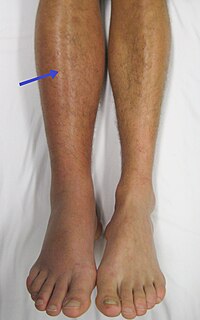
Photo from wikipedia
OBJECTIVE To evaluate the safety and efficacy of posterior-only surgical correction with heavy halo-femoral traction for the treatment of severe and rigid congenital scoliosis (SRCS) associated with tethered spinal cord… Click to show full abstract
OBJECTIVE To evaluate the safety and efficacy of posterior-only surgical correction with heavy halo-femoral traction for the treatment of severe and rigid congenital scoliosis (SRCS) associated with tethered spinal cord (TSC) and Type II split cord malformation (SCM). METHODS 13 patients suffered from SRCS associated with TSC and Type II SCM underwent posterior-only surgical correction with heavy halo-femoral traction. The preoperative mean coronal Cobb angle was 88.87°±12.15°; the mean flexibility was 15.28%±3.88%; the mean angle of thoracic kyphosis (TK) and lumbar lordosis (LL) were 39.63°±18.47° and 56.99°±10.02°, respectively. RESULTS The mean duration of surgery was 320±43.64 min and the mean blood loss was 1422.31±457.59 ml. The mean follow-up period was 24.46±7.53 months. After heavy halo-femoral traction, the mean coronal Cobb angle was reduced to 59.14°±8.75°. After posterior-only surgical correction, postoperative mean coronal Cobb angle was further reduced to 33.85°±8.77°. The postoperative mean correction rate was 62.46%±5.04%. The postoperative mean angle of TK and LL were 29.31°±6.75° and 47.79°±3.68°, respectively. At the final follow up, the corrective loss rate of Cobb angle was only 0.69%. There were no significant differences between final follow-up and preoperative Modified Japanese Orthopaedic Association (mJOA) total scores. The Scoliosis Research Society (SRS)-22 total score improved at the final follow-up evaluation compared with the preoperative total score. CONCLUSIONS Without prophylactic neurosurgical intervention and spine-shortening osteotomy, posterior-only surgical correction with heavy halo-femoral traction could be safe and effective for the treatment of SRCS associated with TSC and Type II SCM.
Journal Title: World neurosurgery
Year Published: 2020
Link to full text (if available)
Share on Social Media: Sign Up to like & get
recommendations!